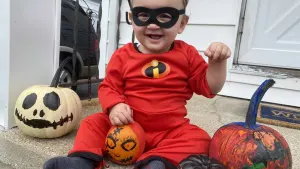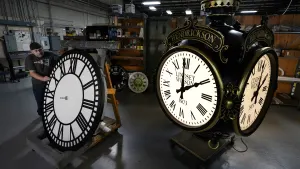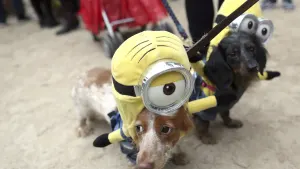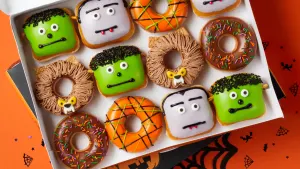More Stories
If you are planning on taking your children trick-or-treating, follow these safety precautions for a fun Halloween:
COSTUMES
All costumes, wigs and accessories should be fire-resistant.
If children are allowed out after dark, fasten reflective tape to their costumes and bags.
When buying Halloween makeup, make sure it is nontoxic and always test it in a small area first. Remove all makeup before children go to bed to prevent skin and eye irritation.
WHILE WALKING
The National Highway Traffic Safety Administration reports that Halloween is consistently one of the top three days for pedestrian injuries and fatalities, and the Centers for Disease Control and Prevention estimates that children are four times more likely to be struck by a motor vehicle on Halloween than any other day of the year.
Make sure you are seen! Wear reflective tape, use glowsticks or carry a flashlight. Watch how some kids do it below:
A responsible adult should accompany young children on the neighborhood rounds.
If your older children are going alone, plan and review a route acceptable to you.
Instruct children to travel only in familiar, well-lit areas and stick with their friends.
Agree on a specific time children should return home.
Children and adults put electronic devices down, keep heads up and walk, don't run, across the street.
Cross at corners, using traffic signals and crosswalks.
Teach children to say “NO!” in a loud voice if someone tries to get them to go somewhere, accept anything other than a treat, or leave with them. Tell them to try everything they can to escape, including yelling, hitting, and kicking.
Carving a pumpkin? Here are safety tips so injuries don't creep up on you.
WHILE DRIVING
Slow down in residential neighborhoods and obey all traffic signs and signals. Drive at least 5 mph below the posted speed limit to give yourself extra time to react to children who may dart into the street.
Watch for children walking on roadways, medians and curbs. In dark costumes, they’ll be harder to see at night.
Look for children crossing the street. They may not be paying attention to traffic and cross the street mid-block or between parked cars.
Carefully enter and exit driveways and alleys.
Turn on your headlights to make yourself more visible – even in the daylight.
Broaden your scanning by looking for children left and right into yards and front porches.
HOW TO HAVE AN INCLUSIVE HALLOWEEN
The tips below from Michael Urban can help people be mindful and inclusive of all people this Halloween.
Urban, is a senior lecturer, program director and doctor of occupational therapy at the University of New Haven.
- It is important to let Halloween participants choose how they wish to participate (e.g., sensory and mobility friendly clothing, use of mobility devices, use of ear plugs, use of lighting devices).
- Consider neighborhood trick or treating during daytime hours. Children of all abilities will be able to successfully navigate the physical (e.g., curbs and steps, visual cues, lighting), social (e.g., unfamiliar faces, unexpected trick or treaters, and the variety of costumes), and sensory (e.g., crowds, loud and unexpected noises, bright and blinking lights, and unfamiliar routines) obstacles.
- To promote accessibility, set up Halloween distribution near the sidewalk or at the end of the driveway. Keep sidewalks clear for children using mobility devices (e.g., cane, walkers, wheelchairs).
- Provide a range of treat options (nut free options, non-food option, like stickers, plastic rings, glow in the dark items.)
- Consider placing signage alerting children and their caregivers of decorations that are frightening, make loud or unexpected sounds, or move unexpectedly (e.g., “Caution: Items may jump out or make noise unexpectedly."). Creative signage can contribute to the scary scene and provide options for those who choose to avoid these stimuli.
- The Teal Pumpkin Project: Putting a teal pumpkin on your doorstep means you have non-food treats available, such as glow sticks or small toys. This simple act promotes inclusion for trick-or-treaters with food allergies or other conditions.
- The Blue Bucket Project: Blue Buckets signal that a Halloween participant may experience trick or treating in a different way.
- Some children may not be able to verbalize the traditional “trick or treat” request. A child looking at (even if fleetingly) and/or approaching the person with the candy, holding out an open bag, or encouraged by a Halloween partner may be communicating their desire to participate in the Halloween tradition.
- Because some children may be physically unable to draw a treat from a bowl or may not understand “just pick one,” distribute the treats individually in the child’s hand or bag or place them individually on the table for children to take.
More safety tips:
More from News 12

Your Connecticut Halloween Photos

Ready to explore the great outdoors? These 14 tips can help you stay safe while hiking
1:32

Slippery leaves. Dark roads. Prepare for fall driving risks with 17 safety tips
2:25

Daylight Saving Time ends. Here are some tips to help you ease into it.
0:25

8 tips to keep your furry friends safe during Halloween
